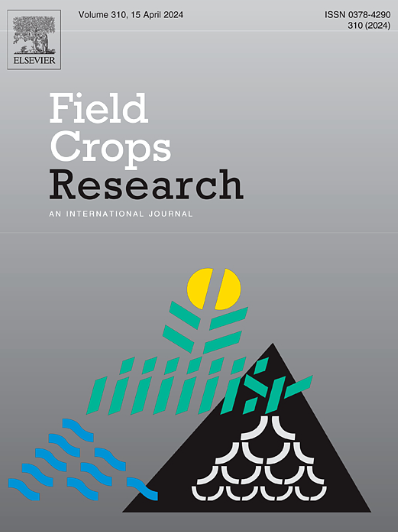Straw mulching optimized the root and canopy structure of soybean by reducing the topsoil temperature before blooming period
IF 5.6
1区 农林科学
Q1 AGRONOMY
引用次数: 0
Abstract
Context
The soybean seed yield in the Huang-Huai-Hai (HHH) region is challenged by high temperatures before blooming. Straw mulching can act to reduce topsoil temperature. However, little is known about whether changes in topsoil temperature contribute to the optimization of soybean root and canopy structure and, ultimately, yield.
Objective
The aim of this study is to investigate the effects of straw mulching on soybean topsoil temperature, root growth, and canopy structure in the HHH region, China.
Methods
A randomized block design was adopted (2020–2023) in the field, including three straw treatments: straw removing (SR), straw mulching (SM), and straw crushing (SC). Topsoil temperature, root morphology, leaf area index (LAI), light transmittance, canopy photosynthesis, dry matter accumulation, and seed yield of soybean under different treatments were measured. Furthermore, the test results were validated by pot experiment (LT: topsoil cooling, CT: topsoil non-cooling) in 2024.
Results
Before soybean blooming, the highest topsoil temperature was 28.47℃ in SR, followed by 27.47℃ in SC and 26.95℃ in SM. Compared to SR and SC, the root length, root surface area, root volume and root dry weight of SM increased by an average of 26.04 %, 27.79 %, 29.13 % and 38.82 %, respectively. Soybean root dry matter weight was significantly positively correlated (P < 0.01) with the LAI and above-ground dry matter accumulation. Compared to SR and SC, Fv/Fm, Y(II), and ETR under SM treatment increased by 8.38 %, 7.94 %, and 7.73 %, respectively. Y(II) of the LT treatment was also significantly (P < 0.05) increased by 17.53 % compared to CT. Among the three treatments, soybean canopy photosynthetic rate and seed yield under SM treatment were, on average, significantly increased by 9.97 %, and 11.87 %, respectively. Furthermore, we identified the LAI characteristics of high-yield soybean canopy: 2.22 <LAI< 2.44 in the upper layer, 1.71 <LAI< 3.21 in the middle layer, and LAI> 0.62 in the lower layer.
Conclusion and implications
These findings imply that regulating topsoil temperature through straw mulching optimizes root and canopy development, improving soybean yield. This study provides insights into mitigating heat stress and enhancing sustainable soybean production in warm climates.
秸秆覆盖通过降低花期前表层土壤温度,优化了大豆根系和冠层结构
黄淮海地区大豆种子产量受到开花前高温的影响。秸秆覆盖可以降低表层土壤温度。然而,对于表土温度的变化是否有助于大豆根系和冠层结构的优化,并最终影响产量,人们知之甚少。目的研究秸秆覆盖对HHH地区大豆表层土壤温度、根系生长和冠层结构的影响。方法采用随机区组设计(2020-2023年),采用秸秆去除(SR)、秸秆覆盖(SM)和秸秆粉碎(SC) 3种秸秆处理。测定了不同处理下大豆的表层土壤温度、根系形态、叶面积指数(LAI)、透光率、冠层光合作用、干物质积累和种子产量。并于2024年通过盆栽试验(LT:表层土冷却,CT:表层土不冷却)对试验结果进行了验证。结果大豆开花前表层土壤温度SR最高,为28.47℃,SC次之,为27.47℃,SM为26.95℃。SM处理的根长、根表面积、根体积和根干重分别比SR处理和SC处理平均增加26.04 %、27.79 %、29.13 %和38.82 %。大豆根系干物质质量与叶面积指数和地上干物质积累呈极显著正相关(P <; 0.01)。与SR和SC相比,SM处理的Fv/Fm、Y(II)和ETR分别提高了8.38 %、7.94 %和7.73 %。与CT相比,LT治疗组Y(II)也显著升高(P <; 0.05),升高17.53 %。在3个处理中,SM处理的大豆冠层光合速率和种子产量平均显著提高了9.97 %和11.87 %。进一步,我们确定了高产大豆冠层LAI特征:上层为2.22 <LAI<; 2.44,中层为1.71 <LAI<; 3.21,下层为LAI>; 0.62。结论与意义通过秸秆覆盖调节表层土壤温度可优化大豆根系和冠层发育,提高大豆产量。该研究为缓解热应激和提高温暖气候下大豆的可持续生产提供了见解。
本文章由计算机程序翻译,如有差异,请以英文原文为准。
求助全文
约1分钟内获得全文
求助全文
来源期刊

Field Crops Research
农林科学-农艺学
CiteScore
9.60
自引率
12.10%
发文量
307
审稿时长
46 days
期刊介绍:
Field Crops Research is an international journal publishing scientific articles on:
√ experimental and modelling research at field, farm and landscape levels
on temperate and tropical crops and cropping systems,
with a focus on crop ecology and physiology, agronomy, and plant genetics and breeding.
 求助内容:
求助内容: 应助结果提醒方式:
应助结果提醒方式:


